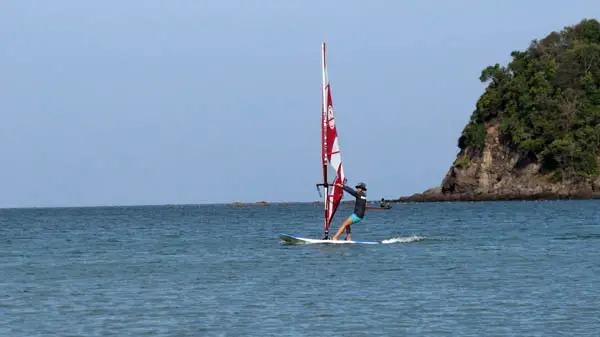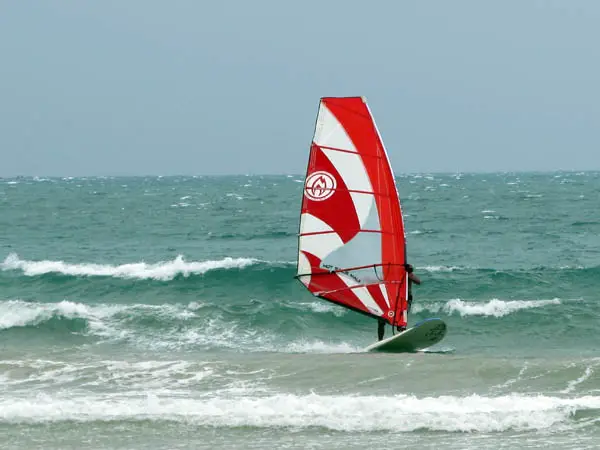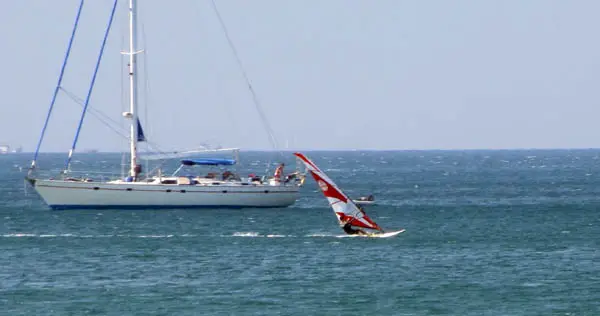In Southeast Asia, Myanmar, Indonesia and Thailand are considered major powerhouses when it comes to windsurfing, mainly because of their immediate position to large bodies of water and decent wind conditions. At the SEA Games in Indonesia in 2011, the Thai windsurfers returned home with three gold medals out of the four on offer, plus a silver and a bronze.
Other countries in the region, such as Vietnam, have made a name for wind sports because they get high and consistent winds, whereas winds in Thailand can be rapidly changeable and inconsistent, especially in the south. Although Thailand is not a destination for wind sports, it offers tourists a variety of activities to do while on holiday, including windsurfing.
Thailand abounds in windsurfing locations, with Pattaya, Krabi and the islands of Samui and Phuket being the most obvious choices. Among these, Pattaya is traditionally the most popular location for windsurfing because of its suitable wind and its proximity to Bangkok. Pattaya has also established many good watersporting events, so it has a larger windsurfing community and many watersport schools are based there.
Still, for holiday goers who want to escape the madness of Pattaya, Koh Lanta proves to be an ideal place to learn to windsurf. As a national park island, Koh Lanta does not allow motorized watercraft to operate from its beaches so there are no obstacles such as jet skis, banana boats and parasailing to interrupt windsurfers. In addition, it is a safe environment, because the beaches there are shallow and there are no rocks to accidently run over.
Sam Konstantinou is a 54-year-old watersports instructor who spends his time between Thailand and his home country Australia, living the dream of any beach lover, chilling out in the sun all day long and doing what he likes most. In 2008, he moved to Koh Lanta in the Krabi Province where he started Koh Lanta Watersports, a company which specialises in teaching surfing, stand up paddleboarding, windsurfing and kiting.
Sam started windsurfing when the sport first started in the 1970’s, a time when the masts and booms were made directly from timber. “I owned the catamaran hire on Noosa Heads Beach in Australia and to learn I was given an A4 sheet on what to do, along with a couple of instructions, then told to give it a go. Windsurfing added to my love of watersports, of which surfing is my passion. Noosa Heads in Australia is a very well known surf point break and was my home before Thailand,” he said.
Sam started his company with the intention of offering a new experience to tourists who wanted to try a more challenging physical activity while on holiday. He had the knowledge and was in the perfect location, so he gave it a try. Over the years, the company has seen an increasing number of people who come specifically to learn windsurfing with Koh Lanta Watersports, even surfers choosing Krabi rather than the famous Bali. This in turn, of course, supports the island’s economy with more tourists staying in local accommodation and spending more time there than elsewhere.
Windsurfing is done at Klong Dao beach on Koh Lanta using a variety of boards depending on the wind conditions. “A board with volume is good as the wind can drop quickly. A wave board is good from May to September, and in high season flat water boards are suitable, the wind is off shore then and although it can be gusty, high speed runs can be had by an experienced windsurfer,” Sam explained.
Koh Lanta Watersports headquarters are on the beachfront, at Costa Lanta Resort, at the north end of Klong Dao. “As I run a school most of the boards are suitable for beginners and ‘againers’ – people who used to do the sports long ago, and want to try it again. Windsurfing is like riding a bicycle – once you know how then you can continue to do it. I use a unique method of teaching. Firstly, I use a simulator on the beach then, once the student has gained their balance and is sailing I will follow them on a stand-up paddleboard, instructing them from this.”
Although you’re at the mercy of two great elements, water and wind, windsurfing is a safe sport. Koh Lanta Watersports is very safety conscious and will not operate in unsuitable conditions, such as thunderstorms. Students are also supervised at all times and all the equipment is well maintained and, most importantly, is selected to suit the abilities of the client.
The number of students who have learned with Sam Konstantinou at Koh Lanta is in the hundreds, from a primary school Thai boy to a brain surgeon from Siberia. “Almost all the people who learn with me are on holiday. People from Europe are the most interested as the sport has always been very popular there. Also, as there are many people from Sweden who stay on the island for a few months over their winter and also, whole families give windsurfing a try,” Sam noted. The youngest learner so far has been a six year-old child who sailed with Sam on the board while the oldest was a 72 year old pensioner from Sweden. “Women are very good learners and tend to pick up the sport easily.”
As on Koh Lanta the local people are not really interested in watersports, the percentage of people who windsurf on the island’s beaches are 99% foreigners. “When I first started surfing and windsurfing the locals were amazed to see it,” said Sam. “The fishermen always have a smile on their faces and wave when out in the bay and you’re passing them on a board.”
Windsurfing used to be a very popular sport in Thailand, however kiteboarding has taken over from this. Nevertheless, windsurfing seems to be making some resurgence, and Sam explained why: “Most of the people I teach have always wanted to try it, but have never had the opportunity. So, instead of being bored from sleeping on the sun loungers, tourists give it a try.”
Windsurfing is for people who enjoy the sea and want to try something different. Being out in the bay on a good breeze when the water is clear and gliding above the sea-life can be an unforgettable experience. Windsurfing is easier if you have good balance and some upper body strength, however with the correct technique you don’t need to be an athlete to try it; you just need to listen to your instructor and really want to do it. On top of that, imagine sailing above turtles, rays, and even the occasional manta ray!
Windsurfing equipment is not cheap and it can take tens of thousands of Baht to set up a complete rig, so lessons are much more affordable in Thailand than Europe. At Koh Lanta Watersports, both rental fees and lessons range from 600 Baht to 3,000 Baht and a ‘learn to windsurf course’ takes approximately three hours. However, this will be time well spent as, once in the water, you’ll be sailing independently with confidence.
If Krabi is not on your travel list but you still want to give windsurfing a try, then you can check out these other sites in Pattaya, Koh Samui or Phuket.
A shorter version of this article was initially published in Mango Metro (January 2014, Vol.8, No.2)
Continue browsing our Thailand windsurfing gallery:
[nggallery id=31]






i also wish i do surfing in that place.any way you looks awesome in the picture.